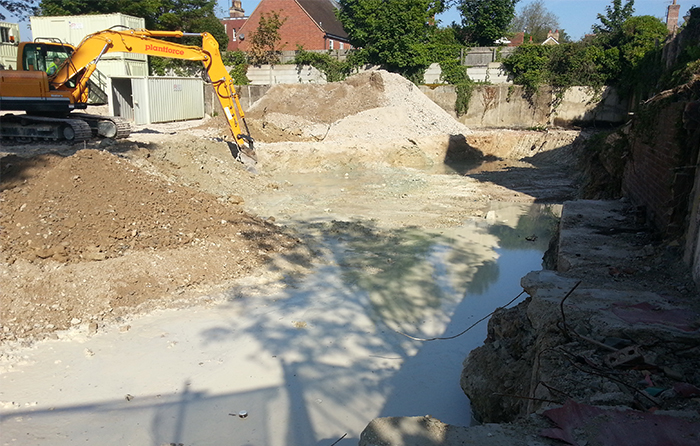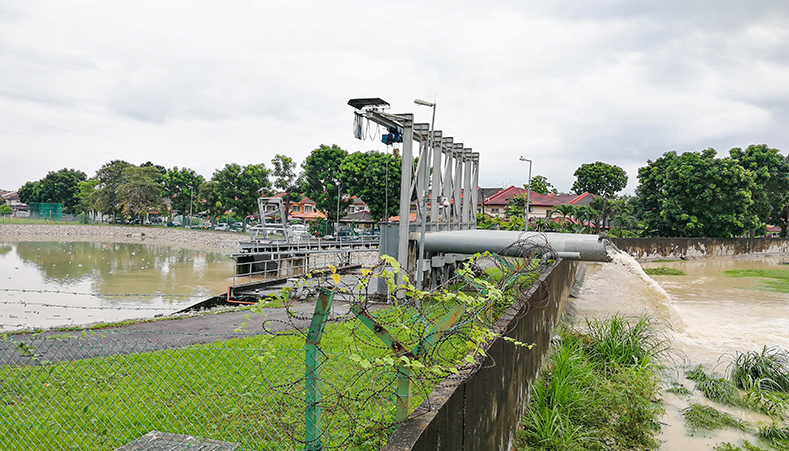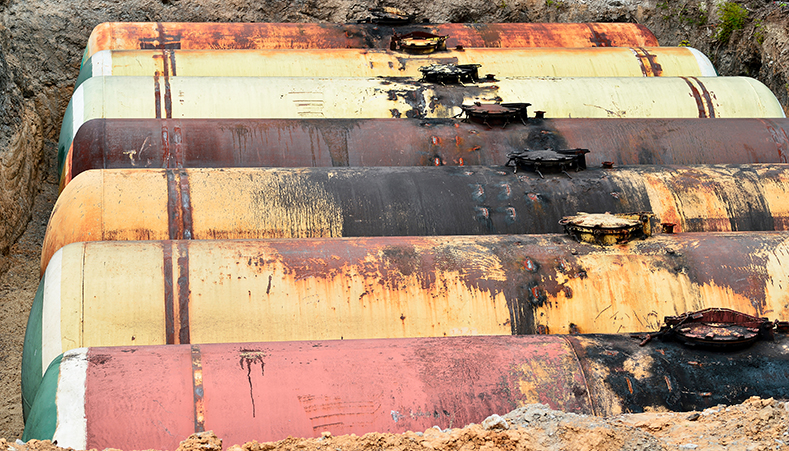Hexavalent Chromium Remediation at Former Saw Mill
Summary
REGENESIS were retained to carry out the remediation design and site application works to treat groundwater impacted with hexavalent chromium (Cr VI) on the site of a former saw mill in the United Kingdom, Europe. Metals Remediation Compound® (MRC) and 3-D Microemulsion® (3DMe) were applied into the groundwater to provide rapid reduction and immobilisation of the CrVI present. Groundwater samples collected 2 months after application were analysed for CrVI , returning non-detect results.
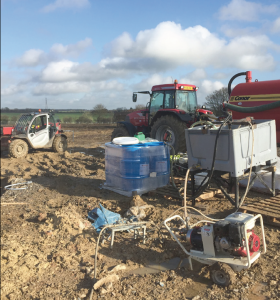
Treatment
Due to the ground conditions of weathered limestone, treatment was carried out via pre-installed treatment wells at 5 m spacing in the source area and 6 m in the barrier. MRC and 3DMe were co-applied into these wells to target the source area of contamination and to install a reactive barrier at the down-gradient edge of the site to protect a nearby watercourse. MRC and 3DMe provide a powerful combination of wide distribution and strong reducing and immobilising properties.
What’s Special?
- REGENESIS’ injection team completed the site works ahead of schedule to allow the groundwork contractor to prepare the site for housing development.
- The use of MRC and 3DMe allowed for wide spacing of the injection wells and therefore lower drilling costs.
- The treatment approach achieved rapid reductions from up to 15,000 μg/L of Cr(VI) to non-detect within two months, expediting regulatory sign-off and unlocking the site for redevelopment
Technology Descriptions
Metals Remediation Compound (MRC) removes metals such as dissolved Cr(VI) from groundwater via in situ immobilisation (precipitation and/or sorption to soil particles).
3-D Microemulsion is an engineered electron donor material that offers a novel 3-stage electron donor release profile, pH neutral chemistry and is delivered on-site as a factory-emulsified product..
Safe and Simple Excavation Application Provides Long-Term Treatment
Summary
During the demolition and redevelopment of a former petrol filling station, an underground storage tank was removed. The tank had been used for the storage of diesel and had leaked into the surrounding soils and groundwater. The impacted soils were excavated and removed to a waste management facility. The groundwater within the excavation was impacted with dissolved phase hydrocarbons and required further treatment.
Regenesis provided the remediation contractor with a remedial design for the application of ORC Advanced Pellets to treat the residual contamination within the groundwater in and around the open excavation.
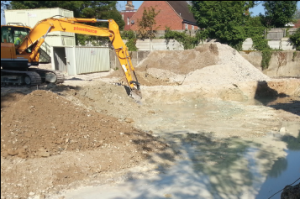
Treatment
ORC Advanced Pellets were applied into the groundwater, in the base of the excavation. This was completed by placing them in an excavator bucket and spreading evenly across the area. By using the pelletised version of ORC Advanced, there was no need for mixing or application using pumps and the potential for dust creation was minimised.
The pellets take only minutes to apply and yet provide a controlled release of oxygen into the groundwater for a period of 9-12 months from a single application. The ORC Advanced stimulates the growth of an aerobic biomass which accelerates the biological degradation of dissolved phase hydrocarbon contamination.
What’s Special?
- The use of ORC Advanced Pellets meant that the contractor could backfill the excavation and continue the build programme with minimal disruption.
- The remediation then continued in situ with no need for physical plant taking up valuable space or requiring maintenance.
- ORC Advanced Pellets provide an effective long-term treatment of residual dissolved phase contamination though a very easy, safe and rapid application process.
Product Description
ORC Advanced Pellets (ORC-A Pellets) are a pelletised version of REGENESIS’ widely-used ORC Advanced and are designed specifically for direct application into excavations, tank pits and trenches. This pelletised, dry application material minimises airborne dust while eliminating the need for specialised equipment and spray water required for powder-slurry applications. ORC Advanced Pellets are approximately 3-10 mm in size.
Enhanced Reductive Dechlorination with Bioaugmentation Treats Source Area, Stops Plume Migration
Combined Remedy Source Treatment Applied at Florida Dry Cleaner
Project Highlights
- Aggressive source treatment to deplete the high-concentration PCE mass
- Plume treatment with a permeable reactive barrier to cut off the plume
- Low-impact direct-push injections in both areas
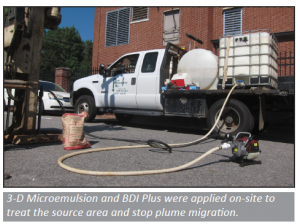
Project Summary
A former dry cleaner in an urban setting in central Florida was contaminated with a PCE plume that extended nearly 1,000 feet downgradient from the source. An extensive treatability test involving multiple emulsified vegetable oils and other electron donor technologies indicated that 3-D Microemulsion® would perform best at the site. An enhanced anaerobic bioremediation treatment was implemented in two areas – the source area near the dry cleaner and an area approximately 500 feet downgradient. A total of 13,900 gallons of 3-D Microemulsion was injected into 30 direct push points in the two areas. In addition, 97 liters of Bio-Dechlor INOCULUM Plus (BDI® Plus) bioaugmentation culture was injected to accelerate treatment results.
Remediation Approach
The injections were performed near the former dry cleaner to deplete the source mass and expedite a transition into natural attenuation monitoring. A plume treatment was implemented as a permeable reactive barrier approximately 500 feet downgradient to help mitigate the risk of additional downgradient migration. Injections were completed using direct-push technology.
Technology Description
3-D Microemulsion is an engineered electron donor technology that offers a novel 3-stage electron donor release profile pH-neutral chemistry, and unique subsurface distribution properties.
Bio-Dechlor INOCULUM Plus is a natural microbial consortium containing species of Dehalococcoides sp. (DHC). This microbial consortium has since been enriched to increase its ability to rapidly dechlorinate contaminants during in situ bioremediation processes.
High TPH Concentrations Treated Using PersulfOx® and ORC® Advanced
Future Site of Stormwater Retention Ponds Remediated with ISCO, Enhanced Aerobic Biodegradation
Project Highlights
- Initial treatment with aerobic bioremediation effectively removed 60% of site contamination.
- PersulfOx® and ORC® Advanced were used to treat two remaining hot spot areas.
- Site closure is pending additional groundwater monitoring.
- Contamination concentrations must be reduced to meet stringent groundwater quality standards.

Project Summary
This site is a former commercial facility in the Southeast with high TRPH contaminant impacts to soils and groundwater. The property is currently vacant and the state department of transportation plans to create a stormwater retention pond on site. However, contaminant concentrations in groundwater need to be reduced to meet stringent groundwater quality standards before any construction can begin.
The plume was first treated via enhanced aerobic bioremediation with ORC Advanced, which effectively removed over 60% of the dissolved-phase contamination within 18 months. In two hot spot areas, residual contamination in the smear zone continued to cause impacts to groundwater. A follow-up treatment combining in situ chemical oxidation and enhacned aerobic bioremediation was employed. PersulfOx and ORC Advanced were used to bring this site towards closure by effectively treating these two hot spot areas. Initial sampling results 30 days after treatment showed attainment of groundwater quality standards.
Remediation Approach
ORC Advanced was injected over 60 direct-push locations across two plume areas. A year and a half post-application, two remaining hot spot areas with residual capillary fringe contamination had caused continued issues. PersulfOx and ORC Advanced were used to bring this site towards closure by effectively treating these two hot spot areas.
Technology Description
ORC Advanced is a proprietary formulation of food-grade, calcium oxy-hydroxide that produces a controlled-release of molecular oxygen for periods of up to 12 months upon hydration.
PersulfOx is a sodium persulfate-based chemical oxidation technology which destroys both hydrocarbon and chlorinated solvent-type contaminants in the subsurface. PersulfOx contains a built-in catalyst which activates the persulfate component and generates contaminant-destroying free radicals without the need for the addition of a separate activator.
RegenOx® Excavation Application Treats Groundwater Contamination
80% TPH Concentration Reduction at California DoD Facility
Project Highlights
- Source removal and RegenOx® ISCO application reduce contamination levels to clean-up standards
- Horizontal piping network installed as contingency plan for additional remediation
- 80% reduction in groundwater concentrations observed

Project Summary
The project site is a former Department of Defense (DoD) fuel dispenser facility in Northern California where past corrective measures included AST/UST removal, soils excavation and groundwater monitoring. Sample results indicated continued elevated concentration levels of TPH-G, TPH-D and TPH-mo within a defined area near the former USTs. The treatment approach included additional excavation and in situ chemical oxidation (ISCO) application via RegenOx mixed into saturated zone. Quarterly sampling indicated an 80% reduction in groundwater concentration levels post treatment; which met the corrective action cleanup levels for TPH.
Remediation Approach
The selected contractor excavated, managed and disposed of impacted soils to depths of nine feet over the two defined treatment areas. RegenOx Part A (oxidizer) and Part B (silica gel activator solution) were placed in the saturated zone and mixed in with the excavator bucket to 3 feet below the excavation bottom. Prior to backfill and compaction, a horizontal piping network was installed to serve as a contingency plan in the event that any additional in situ and/or bioremediation remediation was required. Regenesis assisted the client with the horizontal piping network design which was incorporated into the bid specifications. This site area has been submitted for closure and with continued quarterly monitoring.
Technology Description
RegenOx is an advanced chemical oxidation technology that destroys contaminants through powerful, yet controlled chemical reactions and not through biological means. This product maximizes in situ performance while using a solid alkaline oxidant that employs a sodium percarbonate complex with a multi-part catalytic formula.
Acetone and Petroleum Hydrocarbons Treated at Active Industrial Facility
Combined ISCO/Bioremediation Treatment Approach Reduces Contamination Levels
Project Highlights
- Acetone concentrations pre-remedation were as high as 54,000 μg/L
- Site access agreement required that existing site operations could not be interrupted for construction
- Site water was not allowed to be used therefore all water had to be trucked in and a separate water permit to access city water from fire hydrants was required
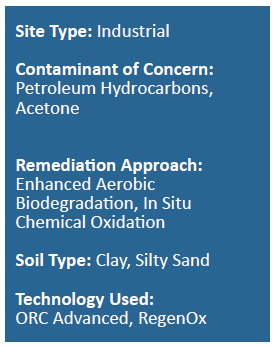
Project Summary
A former industrial facility in northern California operated as a gas manufacturing plant from the early 1900s until it was decommissioned in 2001 and sold. The property is currently leased by a bottled water distribution facility.
At this facility, acetone was used extensively in acetylene manufacturing. The acetone was stored on-site in underground storage tanks (UST) but no evidence of leaking acetone USTs was found.
However, high concentrations of acetone – a pre-remediation maximum of 54,000 micrograms per liter (μg/L) were found in one area of the site. Other dissolved chemicals of concern (COC) include gasoline and gasoline-range petroleum hydrocarbons from former USTs such as benzene, toluene, ethylbenzene and xylenes (BTEX).
The extent of contamination in the early 1990s extended to large portions of the site. A pump and treat system was used on-site in 2005, however contamination persisted. Contamination approximately 12 feet below ground surface was detected within the soil. A remediation plan using both ORC® Advanced and RegenOx® was used to treat the remaining contamination.
The site access agreement for this project required that existing site operations could not be interrupted for construction. In order to minimize disturbance to tenants and work within these constraints, all drilling field work was performed on weekends. Site water was not allowed to be used therefore all water had to be trucked in and a separate water permit to access city water from fire hydrants was required. In addition, multiple drill rigs and support vehicles operated within a small area, increasing logistical and safety concerns.
Remediation Approach
A mixture of 6,500 pounds of RegenOx and 3,000 pounds of ORC Advanced was injected at 45 locations using multiple direct-push drill rigs. The injection points were designed in a grid pattern with a nominal 15-foot spacing between injection points, but more densely placed in the area of highest contaminant concentration. Benzene concentrations in groundwater have stabilized at about 10 μg/L and acetone concentrations have stabilized at about 1,600 μg/L. Post-treatment monitoring results show that all the COCs in the treatment area have consistently remained below health-based cleanup levels since the treatment was applied.
Technology Description
Advanced Formula Oxygen Release Compound (ORC Advanced®) is a proprietary formulation of food-grade, calcium oxy-hydroxide that produces a controlled-release of molecular oxygen for periods of up to 12 months upon hydration.
RegenOx is an advanced chemical oxidation technology that destroys contaminants through powerful, yet controlled chemical reactions and not through biological means. This product maximizes in situ performance while using a solid alkaline oxidant that employs a sodium percarbonate complex with a multi-part catalytic formula.
Open Excavation Treatment at Former NJ Service Station
RegenOx® and ORC® Advanced Pellets Remediate Petroleum Hydrocarbon Contamination
Project Highlights
- Former service station contaminated with BTEX levels measuring 11 ppm in groundwater and soil impacts removed through excavation
- Combined remedy to treat the open excavation with both in situ chemical oxidation and enhanced aerobic bioremediation technologies
- RegenOx and ORC Advanced Pellets technologies are compatible/non-corrosive with underground infrastructure and utilities infrastructure in the subsurface

Project Summary
A former service station in New Jersey was contaminated with high levels of BTEX (measuring 11 ppm in groundwater pre-treatment). Due to significant amounts of contaminated soil mass remaining at the former service station, an excavation was proposed by the environmental consultant. RegenOx and ORC Advanced Pellets were applied to the open excavation to chemically oxidize remaining saturated impacts and to promote enhanced aerobic biodegradation of petroleum hydrocarbons in the dissolved phase. Both of these technologies utilize alkaline chemistry (pH > 8), which is non-corrosive to nearby public utilities and the underground infrastructure at the service station.
Remediation Approach
RegenOx and ORC Advanced were co-applied into an open excavation at the former service station site. The excavation extended approximately four feet into the saturated zone. Because the excavation was limited by physical constraints, RegenOx, a chemical oxidant, was applied to the base of the excavation to oxidize and desorb residual petroleum mass from the soil. ORC Advanced Pellets were co-applied to provide a slow release of oxygen (up to 12 months longevity) that promotes enhanced aerobic biodegradation of petroleum hydrocarbons. In total, 2,000 pounds of RegenOx and 882 pounds of ORC Advanced Pellets were co-applied to the 2,600 square foot excavation area.
Technology Description
The advanced formulation of the Oxygen Release Compound (ORC Advanced) is a proprietary formulation of food-grade, calcium oxy-hydroxide that produces a controlled-release of molecular oxygen for periods of up to 12 months upon hydration. The pelletized form of ORC Advanced were designed to improve safety and handling for excavation applications.
RegenOx is an advanced chemical oxidation technology that destroys contaminants through powerful, yet controlled direct oxidation and free-radical reactions. This product maximizes in situ performance through the use of a solid alkaline oxidant (a sodium percarbonate complex) and a multi-part catalyst. These oxidation reactions do not inhibit natural bacterial populations and are compatible with biological treatment methods.
Cost-Effective Remediation Plan Implemented at Active Texas Dry Cleaner
3-D Microemulsion® Reduces Chlorinated Solvent Contamination to Clean-Up Standards
Project Highlights
- Dual-phase extraction used to treat high level PCE in the source area.
- Enhanced Anaerobic Bioremediation selected as a cost-effective approach to treating migrating contamination.
- Majority of contamination reduced to clean-up standards; two low-level VC areas remain above desired limits.

Project Summary
Dry cleaning operations resulted in a PCE release at a Texas dry cleaner. PCE concentrations at high at 95 mg/L were observed on-site. Aggressive clean-up measures were used in the form of dual-phase extraction of DNAPL and solvents in the source area. This resulted in nearly a two order-of-magnitude reduction in PCE concentrations in certain source wells. The second clean-up phase included expanding the system to treat contamination that had migrated out of the source area into the periphery of the groundwater plume.
Remediation Approach
Due to a limited budget for remediation, a cost-effective anaerobic bioremediation approach was selected due to the desire for a long-lasting solution that could also achieve low concentrations. 3-D Microemulsion and HRC Primer were injected along the migration centerline of the plume extending from just outside the source area to the toe of the plume. A second smaller treatment event was conducted in the vicinity of the former source area.
One year post-injection all solvent concentrations have dropped below clean-up standards with the exception of two low-level contamination areas. Recent treatment of the source area is starting to result in similar trends although there is not enough data yet to track remediation progress of the second injection event.
However, biostimulation alone through the addition of 3-D Microemulsion and HRC Primer appears to be very effective. Ongoing monitoring will occur followed by initiation of closure monitoring once all critical wells reach target levels.
Technology Description
3-D Microemulsion is an engineered electron donor material that offers a novel 3-stage electron donor release profile, pH neutral chemistry and is delivered on-site as a factory-emulsified product.
HRC Primer is a less viscous version of the standard Hydrogen Release Compound (HRC) product. It is a thinner, water-like compound that is typically injected into an aquifer where it releases lactic acid at a rate faster than standard HRC (several weeks), but at a slower, more controlled rate than dispersing aqueous simple sugar solutions or straight lactic acid (several days).
Combined Remedies Treat BTEX Contamination on Government Property
Ontario, Canada Site Remediated with ORC® Advanced and RegenOx®
Project Highlights
- In Situ Chemical Oxidation (ISCO) and Enhanced Biodegradation used post-excavation to treat residual contamination.
- Extensive site mapping conducted with membrane interface probe (MIP) to detect distinct zones of higher mass contamination.
- 95% reductions seen in dissolved phase petroleum hydrocarbon contamination.
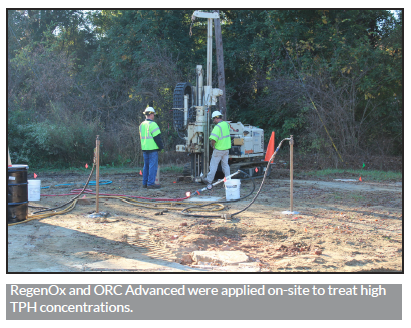
Project Summary
A large public works property in Ontario, Canada was contaminated with TPH. Approximately 5,000 gallons of fuel was released into the subsurface primarily due to fuel theft that had taken place on-site. Due to significant volumes of free-product, an excavation occurred followed by skimming activities from 2005-2010. Through extensive site evaluation, it was determined that there was a need for further mass reduction using ISCO.. RegenOx® ISCO was selected for use in the heavily and moderately impacted areas. Enhanced aerobic biodegradation using ORC® Advanced was selected for use in the dissolved-phase areas downgradient from the source. Overall, 96% reductions were seen in dissolved phase petroleum hydrocarbon concentrations.
Remediation Approach
Membrane interface probe (MIP) data was collected and proved to be integral for the remediation design and implementation. Distinct zones with high mass were present on-site and detected through the probe. RegenOx and ORC Advanced were applied via direct-push injections. Approximately 150,000 pounds of RegenOx and 45,000 pounds of ORC Advanced were applied over several injections. Higher concentrations of RegenOx were applied into the vertical zones of higher contamination to improve overall product performance.
Technology Description
Advanced Formula Oxygen Release Compound is a proprietary formulation of food-grade, calcium oxy-hydroxide that produces a controlled-release of molecular oxygen for periods of up to 12 months upon hydration.
RegenOx is an advanced chemical oxidation technology that destroys contaminants through powerful, yet controlled chemical reactions and not through biological means. This product maximizes in situ performance while using a solid alkaline oxidant that employs a sodium percarbonate complex with a multi-part catalytic formula.
PersulfOx® Treats Gasoline Tanker Truck Spill Site
Pilot Study Moved to Full-Scale Application to Remediated Benzene and TPH-G Contamination
Project Highlights
- Pilot study moves to full-scale application after large contamination concentration decrease resulting from in situ chemical oxidation (ISCO).
- High-volume, direct-injection of PersulfOx® ISCO distributes reagent beneath highway.
- ORC Advanced applied to edge of plume to prevent further migration.
- The average reductions of benzene or TPH-G were 83% and 79% respectively.
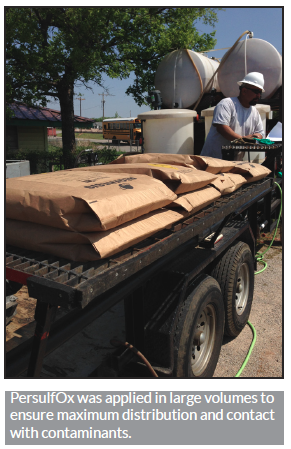
Project Summary
A gasoline tanker truck rollover occurred in Ringling, Oklahoma resulting in a benzene and TPH-G contamination. A pilot study using PersulfOx ISCO was conducted with up to 98% contamination reduction observed. Upon successful completion of the pilot study, a full-scale application was approved. A series of full-scale ISCO applications commenced to achieve significant knockdown of benzene and TPH-G concentrations at the site.
Remediation Approach
Full-scale PersulfOx injections were focused along a run-off ditch on the east side of the highway where contamination reached the groundwater during the initial spill and also downgradient on the west side of the highway where contamination had migrated.
The intent of injections on the east side of the highway were designed to address source contamination. These injections were also designed to treat the contamination beneath the highway. PersulfOx migrated through the aquifer under the influence of large direct-push injection volumes and a strong underlying groundwater gradient and natural slope of the lower confining bedrock.
Two PersulfOx injections have been completed approximately one month apart while an application of ORC Advanced also was applied in the distal part of the plume to prevent further spreading of BTEX and TPH.
The average reductions of benzene or TPH-G were 83% and 79% respectively. These are encouraging results and indicate beneficial oxidation and mass reduction of fuel hydrocarbon contamination. Ongoing monitoring will determine if additional applications are needed to reach remedial goals.
Technology Description
Advanced Formula Oxygen Release Compound (ORC Advanced®) is a proprietary formulation of food-grade, calcium oxy-hydroxide that produces a controlled-release of molecular oxygen for periods of up to 12 months upon hydration.
PersulfOx is a sodium persulfate-based chemical oxidation technology which destroys both hydrocarbon and chlorinated solvent-type contaminants in the subsurface. PersulfOx contains a built-in catalyst which activates the persulfate component and generates contaminant-destroying free radicals without the need for the addition of a separate activator.

 Americas
Americas Europe
Europe Français
Français Deutsch
Deutsch Italiano
Italiano Español
Español
